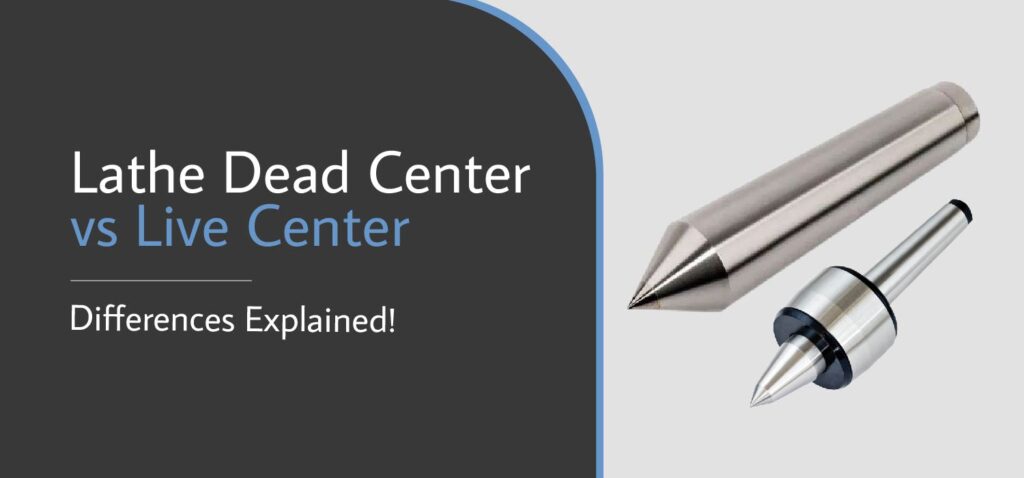Last Updated on January 16, 2023 by Charles Wilson
Many are confused about the differences between the live and dead centers of the lathe machine. These allow you to secure your work-piece to your machine for woodturning, metalworking, etc.
However, to give you a brief distinction, the dead center is just a stationary point, while the live center lathe has a rotating end.
The internal bearings of these two different parts of the lathe machine are vital in cutting a wood block. Thus, it’s essential to understand your drive center and how it helps you work on a solid piece of wood.
Read the article below to help you learn more about dead centers and live centers!
Key Takeaways
- The dead center has no moving parts. It is a piece of a metal shaft with a sharp point.
- A live center has internal bearings that allow it to spin freely.
- A tail stock has a dead center, while a head stock has a live center.
What Are Lathe Dead Centers?

The dead center is built on a stationary point. It is a piece of lathe machine located in the tailstock with no angle. It is primarily used for woodturning.
When used on a tailstock, the dead center rotates slowly. You might need to perform specific applications, such as adding lubricants, to hasten its operation.
TIP: You can use automotive ep grease to fasten the rubbing contact of the wood lathe.
If you are new to a wood lathe, below are the things you must know about dead centers:
- Dead centers are solid and hard with a fixed position of an angle. However, soft dead centers are also available if you want a movable tip.
- Dead centers have more uses than live centers. Although live centers are more popular, dead centers can work with more extensive and heavier machines.
- The dead center produces friction on a tailstock. This is because of the constant contact between the workpiece and the center, leading to burning on a tailstock. (NOTE: having a dead center on the headstock will not cause conflict.)
- Dead centers have a morse taper, just like live centers. Even though it is just a stationary point, this workpiece machine can be used for different operations.
What Is the Function of a Dead Center?
A dead center (the one that does NOT turn freely) supports the workpiece of a fixed or rotating end of the machine.
When used in a fixed position, the dead center produces friction between the workpiece and the live center due to the rotation of the workpiece.
To put it simply, a dead center is used to hold a workpiece in a lathe machine, often between the headstock or tailstock.
Variations of the Dead Center
There are different variations of a live center available on the market. However, only two variations are considered notable, and these are:
Drive Center
If you want a machine that looks like the typical dead center, drive centers are for you! It bears like a dead center, except that it has a flattened tip.
This material does not revolve but has tremendous pressure to hold the metal lathe in place. It is commonly used for hard woodcutting operations because of its bearing.
Half-dead Center (Grip Center)
The most popular type is the half-dead center. It works exceptionally for softwood cutting because it has an internal bearing type of grip.
NOTE: Grip centers are commonly used in the headstock.
Additionally, standard dead centers are also available. A standard type has a conical contact surface.
A conical contact surface rotates on an engine lathe and works efficiently when used in a woodcutting operation.
What Are Lathe Live Centers?

Live centers are more popular than dead centers. This workpiece type has moving parts that help it rotate freely.
Ideally, dead centers would be used on the headstock and tailstock when woodturning on a wood lathe.
However, as technology advanced, the dead center was replaced by the live center, becoming the standard for a lathe operation.
This is because dead centers create friction that can cause wood burning. Live centers, on the other hand, have a conical point that moves freely without the risk of burning.
TIP: Live centers are ideal for quick turning speeds without lubrication.
If you are new to the world of wood lathe machining, below are the things you must know about live centers:
- Live centers have a tapered shaft called a morse taper. This material will be inserted on the headstock or tailstock and has a ball feature that allows it to move.
- Live centers are excellent for providing extra support for spindle work. This is because the shaft of the live center can clamp down the hardwood. You won’t have to worry about friction on the rubbing contact because this workpiece does not create friction on a spindle.
- Live centers have different points that can be switched out. Because this lathe is not a hard piece of metal, the tool has a hollow area wherein you can put a knock-out till through for knock-out machining. Also, you can easily remove and replace it with a different one.
What Is the Function of the Live Center?
Like a dead center, a live center holds and supports the machining workpiece in a lathe’s headstock or tailstock.
Live centers have a ring that surrounds its lead screw, so the headstock revolves freely for woodturning.
This machining lathe revolves and spins freely without the risk of wood damage.
Variations of the Live Center
There are different variations of live centers. These include:
- Spring-loaded Centers – Spring-loaded centers are tools with a spring inside for consistent tension on the point of a lathe.
- Pipe Centers – Pipe centers, also known as bullnose centers, have a coned shape and broader diameter instead of a sharp tip. To maintain consistency, the conical contact surface rotates on the included angle of the pole lathes.
- Cup Centers – A cup center is like a standard center, except that it has a ring surrounding the point. The included angle of the ring is made and designed for additional support to the wood.
What Is a Feed Rod?

The feed rod is a power transmission tool used for precise linear movement of the carriage along the longitudinal axis of the lathe.
A set of gears powers the feed rod from the headstock or tailstock, and it rotates during the lathe operation to efficiently provide movement to the carriage.
The feeding rod runs more slowly than the lead screw because it is made for finer feeds. Hence, the tool is made for the operation of thorough wood fining.
Other Types of Centers and Additional Factors
Dead and live centers are the two most common types of lathe centers. However, there are plenty of center lathe varieties available on the market.
There is a swivel v-style center, a self-driving center, a ball center, and many more. You can opt for these types, but remember that naming conventions have not been standardized yet.
That means you should purchase a lath center of an appropriate size and style according to your needs.
TIP: Remember that knowing the materials you are working with, the taper size, and the RPM of your lathe is essential for your safety.
Frequently Asked Questions
Below are some common questions asked about lathe centers:
What Is Cross Slide in Lathe?
A cross slide is a component found on the other end or top of the lathe that allows the tool to slide back and forth.
What Does a Live Center Do That a Dead Center Does Not?
Dead centers do not rotate, unlike live centers. That means the live centers have more bearing features because the tip of their hole freely rotates.
Conclusion
Live and dead centers are the common types of lathe available on the market. Both centers have similar functions but different internal bearings.
Thus, dead centers are for you if you want a stationary hole tool. On the other hand, if you want a lathe center that rotates freely, opt for a live center.
Whatever you choose, make sure it brings safety and convenience whenever you use a lathe!
Thinking of buying a wood lathe? Here’s a guide I made that you can refer to!

